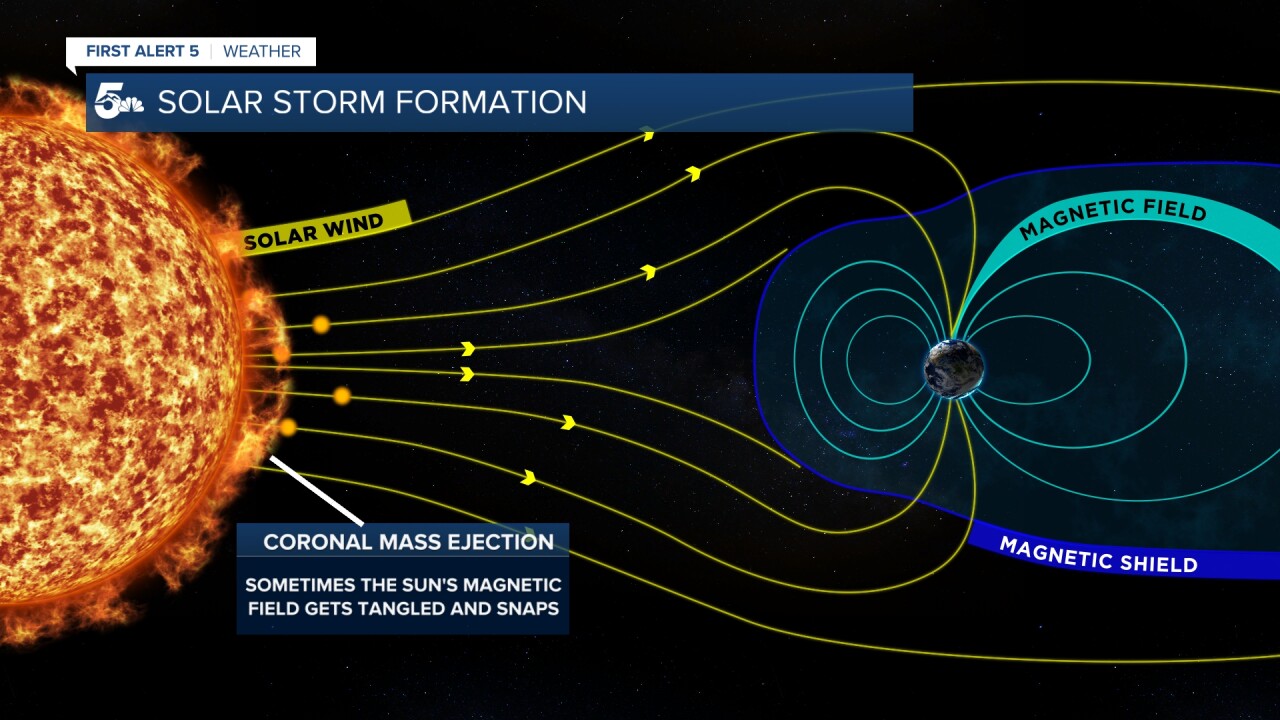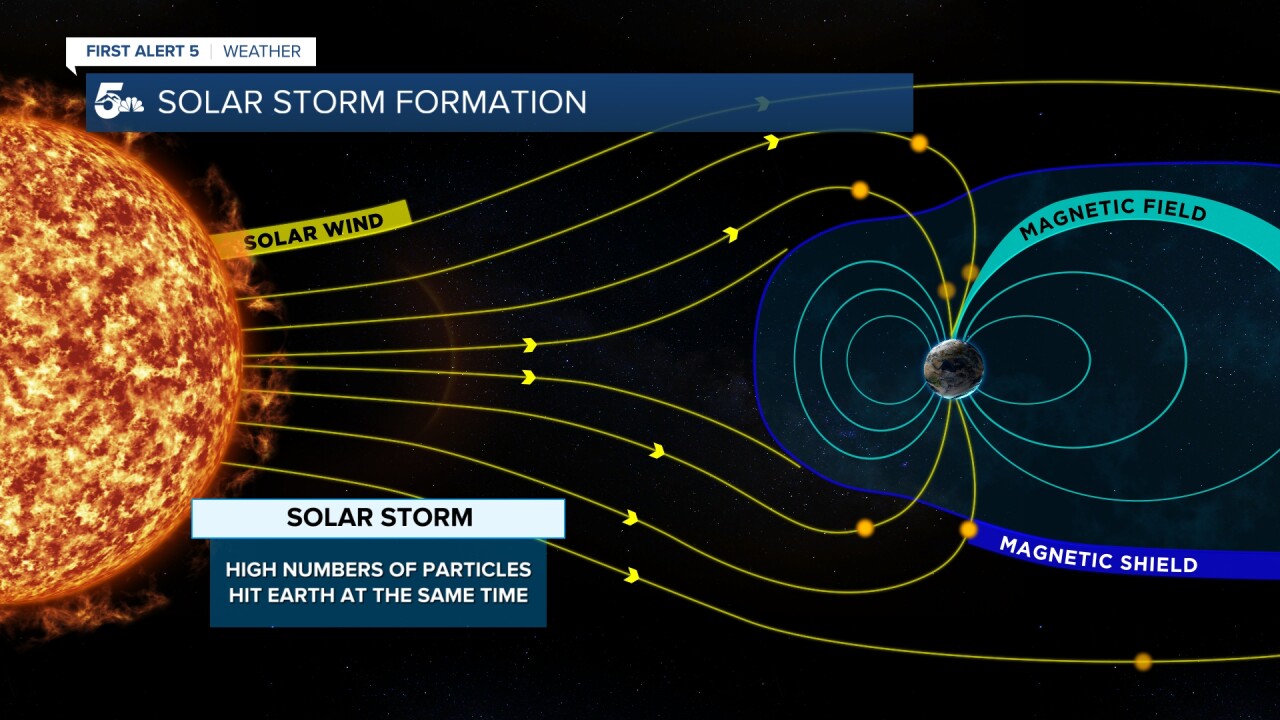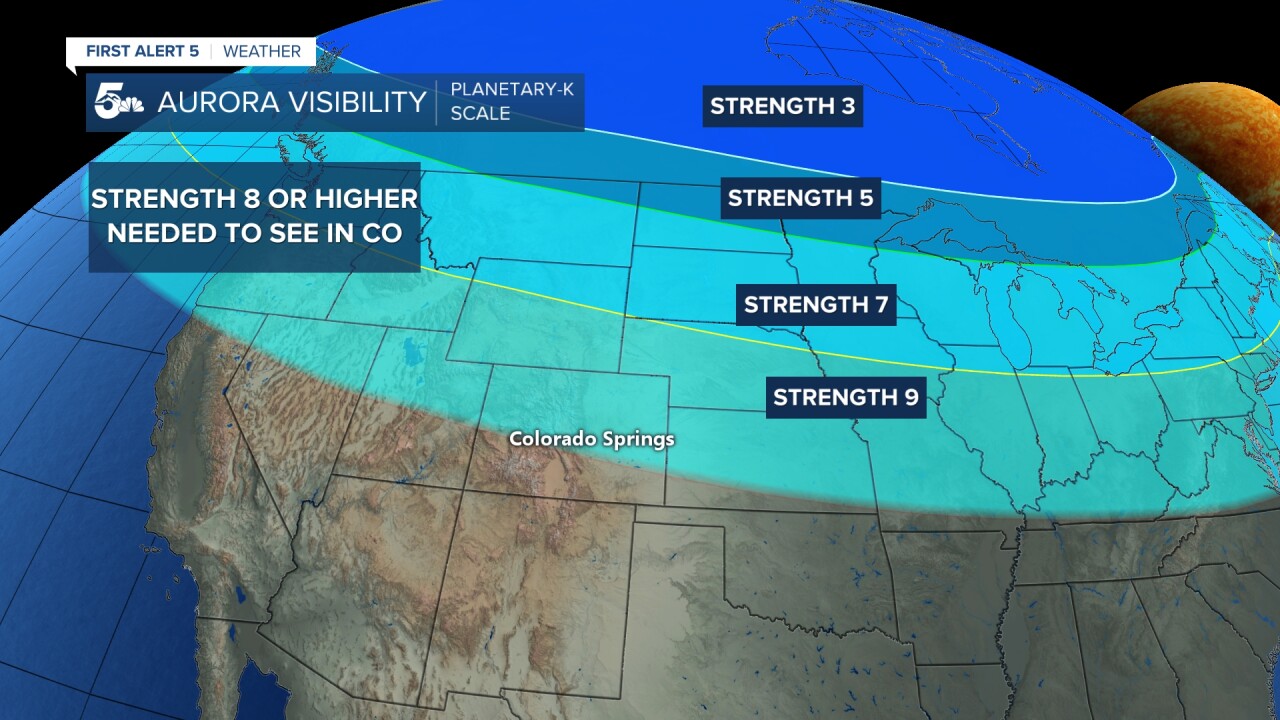Tuesday night's aurora display across Colorado was incredibly vibrant, and in some cases was even more visible than the spectacular show from May 2024 when the largest solar storm in 20 years hit Earth. While it will be hard to beat those views, you have another chance to see the northern lights tonight.
You can scroll down to see the forecast for this evening, or read through to learn about what causes auroras, how they're predicted, and why they sometimes over or underperform the forecast.
AURORA SCIENCE:
The sun has a magnetic field that sometimes gets twisted like a rubber band wound around several times. Just like that rubber band, that twisted magnetic field can snap. When it does, it releases billions of tons of tiny particles in what's called a coronal mass ejection, or CME.

If that CME is pointed toward Earth, we get hit with those particles one to three days later. As the particles crash into Earth's magnetic field, they create a geomagnetic storm.

MEASURING GEOMAGNETIC STORMS:
Scientists measure these storms using two related systems. The geomagnetic storm scale, or G scale, runs from 1 to 5 and rates storms based on their impact, similar to rating a hurricane by category.
The planetary-K index, or Kp scale, runs from 1 to 9 and measures geomagnetic activity, similar to the specific wind speed measured in a hurricane's eye. Space weather experts measure the Kp index using a network of magnetometers, including at the Space Weather Prediction Center in Boulder, CO.
The G-scale corresponds to the upper ends of the Kp scale. It was designed to explain the impact of geomagnetic storms. Geomagnetic storms don't just produce auroras. They can disrupt anything with a circuit board - including radios and telecommunications, satellites, the power grid, and more. Operators of these technologies take steps to protect their devices and grids from impacts of solar storms. The G scale defines what impacts are likely to happen - thereby advising those operators what they need to do.
| G-Scale | Kp Index |
| 1 | 5 |
| 2 | 6 |
| 3 | 7 |
| 4 | 8 |
| 5 | 9 |
SEEING THE AURORA IN COLORADO:

For Colorado to see a visible aurora, we typically need a Kp of 8 - a G4 storm, and for your phone to capture it, we need at least a Kp 7. Tuesday night's event had a Kp very close to the top of the scale.
PRODUCING STRONG SOLAR STORMS:
This gets technical.
The strongest solar storms occur when the sun sends multiple CMEs toward us and they catch up to each other. In general, the speed of the particles and how many of them there are determines how strong a storm is.
The reason speed matters is due to momentum. Think about the difference between a bowling ball hitting some pins at walking speed, versus 100 mph. The faster the storm, the more it tends to disrupt the magnetic field.
Particle density also impacts intensity and how long the storm impacts last. The more particles...the longer the disruption to the field.
But nothing in space weather is straightforward. Earth's magnetic field has a polarity - the way the magnetic field points. When you hold a magnet next to another magnet, sometimes they attract and other times they repel, depending on which direction they're facing. The same is true with CMEs.
When a CME hits Earth, its polarity compared to Earth's determines whether the CME gets pulled into Earth and causes a storm, or if Earth's magnetosphere deflects it. Space weather scientists don't have an easy way to predict this ahead of time. Instead, they have to wait until the storm hits a solar observation satellite that orbits about a million miles away from Earth.
Strong storms require a perfect situation: typically multiple large and powerful CMEs, ideally catching up to each other, moving quickly, and with a polarity that aligns with Earth's magnetic field. That's why intense G-4 and G-5 storms are so rare.
When these ingredients do align, we get situations like Tuesday and tonight. Tuesday, we saw two CMEs combine. They were both (relatively) slow but had a lot of particles, and the polarity was perfect to strongly disrupt Earth's magnetosphere, creating the spectacular display many saw.
TONIGHT'S AURORA FORECAST FOR COLORADO:
Tonight's CME is a single, much faster pulse, with some residual effects from the prior CMEs influencing the behavior of this CME.
Faster generally means stronger when it comes to geomagnetic storms, and this storm is on the extreme upper end in that sense. But the particle density is lower, so the storming may not last as long. The other wild card is the polarity. This cannot be well predicted and ultimately will be why this storm over or underperforms.
Because of the high-end potential, the Space Weather Prediction Center has issued a G4 (or higher) geomagnetic storm watch that is in place for this evening.
With a Kp index of 8 or above, you can see the aurora in Colorado with the naked eye. Given the strength of this storm, you should be able to see the aurora again tonight, but clouds are likely to be more of a factor than Tuesday. Follow our evening weather forecast for the details there.
The strength of the aurora will decrease through the night, and your best chance to see it is before 10 p.m. It is unlikely to be as visible and long lasting as Tuesday's display - so using your phone camera on night mode is a good plan. Your best chance to see it is in a dark sky location free from obstacles and facing north.

WHAT CREATES THE COLORS OF THE AURORA:
The colors occur when solar particles hit our atmosphere and give extra energy to air molecules. Green and red colors are both oxygen at different altitudes. Blues and purples are nitrogen molecules. The more intense the storm and the closer you are to the aurora itself, the more intense the colors will be and the more likely you are to see multiple colors.
While the exact strength of the aurora at a specific time is very hard to predict during a storm, you should still be able to see it tonight where there are breaks in the clouds.
You can check out last night's aurora and photos here or in the viewer below.
____
Have a question or story idea you would like the First Alert 5 Weather team to consider? Email: weather@koaa.com
Watch KOAA News5 on your time, anytime with our free streaming app available for your Roku, FireTV, AppleTV and Android TV. Just search KOAA News5, download and start watching.


